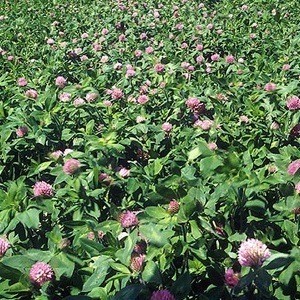
When you put your vegetable garden to bed this fall, consider tucking it in under a cover crop. Also known as "green manure", planting a crop of legumes or cereal grains is a great way to rejuvenate garden soil and get your plants off to the best possible start next season. The basic principle behind growing cover crops is easy: sow the seed, grow the crop, and incorporate the crop back into the soil. The end result is healthy soil and happy plants.
Cover crops differ in sowing times, soil preferences, growing rates, and what they ultimately return to the soil. Deciding which one is best for you isn't complicated, it just depends on what you hope to achieve. For example, Alfalfa is a hardy annual. It's also a legume (fixes nitrogen). It doesn't like wet or acidic soil and it takes a full year to reach maturity. If you want to rest a particular bed for a full season and you have the proper soil, it's a good choice.
Buckwheat, on the other hand, is a half hardy annual. It's a cereal grain. It matures in only 1-2 months and thrives in poor soils. It might be a good choice if you're looking for a crop to grow over the winter.
Here's a handy chart from the Farmer's Almanac listing U.S. Regional Cover Crops. http://www.almanac.com/sites/new.almanac.com/files/USCoverCrops.pdf
An even better chart is this one from The Rodale Institute. It gives a detailed guide to hardiness, seed depth, when to plant, and the main benefits of each crop. http://newfarm.rodaleinstitute.org/features/0104/no-till/chart.shtml
Preparing the bed: Before sowing the seeds of your cover crop, remove any plant debris remaining from your vegetable garden and even out the surface of the soil with a rake.
Sowing the seeds: Broadcast the seed according to directions. Legumes should be treated with an inoculant (available where you buy the seeds) to ensure the bacteria needed to fix nitrogen are present in the soil.
Protecting your crop: If the seeds of your crop start disappearing with neighborhood birds (the can be especially problematic in the fall), cover your crop with netting attached to a wooden framework that holds the netting several inches above the ground. Anchor the sides in place with stones or bricks and leave it on until the seedlings reach several inches tall.
To harvest your crop, take several passes over it with your lawn mower before the stems become too woody. This will chop it up into fine pieces and speed up the rate at which is decomposes in the soil.
Digging it in (turning it under): If you have a large garden, use a roto-tiller on low speed to work the plant material into the soil. Smaller garden beds should be worked by hand to avoid disturbing the soil as much as possible. Once the crop has been turned under, cover the bed with a layer of compost to help speed up decomposition.
The no-dig approach: Another approach to harvesting cover crops is called the "no-dig" technique. Simply cut the crop and leave the plant material to decompose on the ground like grass clippings. You can then plant your garden vegetables through this layer, using the intact stems and roots like a protective mulch.
Timing Your Harvest: It's important to allow yourself plenty of time to harvest and dig in your crop before planting your garden beds. Expect to wait at least 7 to 10 days to plant after harvesting legume crops, and up to two weeks or more after harvesting grain crops. The reason for this is that large amounts of plant material will take several weeks to break down in the soil.
During that time, soil microorganisms will temporarily tie up much of the available nitrogen and the ethylene gas produced from the decomposing plant material will inhibit seed germination and retard the growth of seedlings. When you can no longer tell your cover crop from your garden soil your bed is ready to be planted.

About The Author: Ellen Brown is an environmental writer and photographer and the owner of Sustainable Media, an environmental media company that specializes in helping businesses and organizations promote eco-friendly products and services. Contact her on the web at http://www.sustainable-media.com
Add your voice! Click below to comment. ThriftyFun is powered by your wisdom!